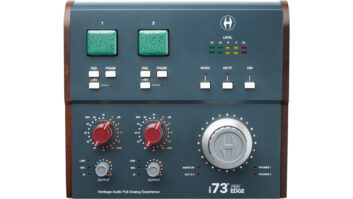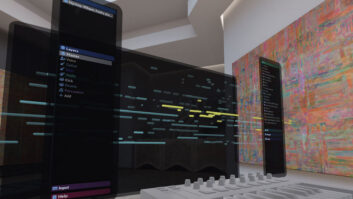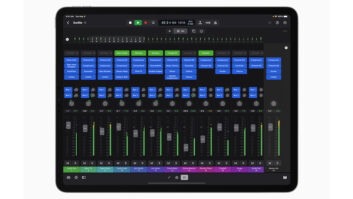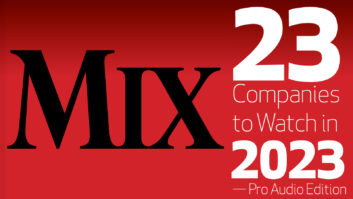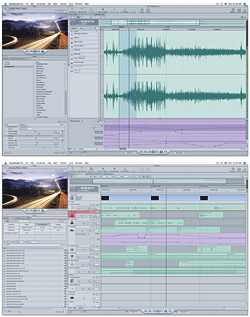
When Apple first unveiled Soundtrack a few years ago, I was impressed by its ability to handle loops and audio clips to quickly create music scores for picture and blend them with audio imported from Final Cut Pro video editing sessions. It was a long way from a full-on DAW, but for those who needed a quick musical fix in the industrial/business/educational video market, it did the trick.
Soundtrack Pro’s Waveform Editor screen (top) allows serious, detailed tweaking. The Project screen is
better suited for coarser manipulations on a more global scale. The purple-shaded sections below the tracks display automated envelope changes for pan, volume and DSP parameters.
Now, Soundtrack has grown up into Soundtrack Pro, which addresses many of the shortcomings that existed with its predecessor while adding a wealth of serious audio tools. Soundtrack Pro is no mere upgrade; it’s a completely new program that retains some of the original’s look and features.
Soundtrack Pro is offered at a bargain $299 (owners of earlier versions can buy it for $99), but I suspect that most users will receive the program as part of Final Cut Studio, a $1,299 suite that includes Final Cut Pro 5, Soundtrack Pro, Motion 2 graphics animation/manipulation and DVD Studio Pro 4 disk authoring. Existing Final Cut Pro owners can upgrade to the entire suite (with the Final Cut Pro 5 upgrade) for $699.
Soundtrack Pro’s new functions are numerous, but before addressing those, be advised that Soundtrack Pro and the new Final Cut Pro 5 were designed around Mac OS 10.4 Tiger, so you may need to upgrade your operating system — although it can operate under OS 10.3.9. Once your OS is in order, installing Soundtrack Pro and Final Cut Pro 5 is painless. Apple recommends running the software on a 500MHz or faster Mac with a G4 or G5 processor and at least 1 GB of RAM.
Soundtrack Pro supports .AIFF, .WAV, MP3, SDII NeXT, QuickTime and STAP (Soundtrack Audio Project) file playback and can export files in STAP, .AIFF, .WAV, SDII or NeXT formats. The program is not a MIDI sequencer, but can send/receive MIDI time code and beat clock to sync with other MIDI devices. Supported sample rates range from 2 kHz to 192 kHz.
After the release of Soundtrack Pro, a number of minor bugs were addressed in Version 1.0.1, including the ability to “round trip” a file back and forth several times between Final Cut Pro 5 and Soundtrack Pro, improved re-draws and more.
NEW FEATURES
The most important feature in Soundtrack Pro is its ability to seamlessly integrate with Final Cut Pro 5, DVD Studio Pro 4 and Motion 2, whereby multitrack clips or single files can be readily opened in Soundtrack Pro and — once tweaked — returned to Final Cut Pro 5. Editing is sample-accurate and non-destructive, with near-unlimited undo. And Soundtrack Pro’s script and batch processing can apply plug-ins, sample rate conversions, amplitude adjustments and more to dozens (or hundreds) of files at once simply by saving the Action as an AppleScript.

Mackie
Control Universal
While not as intensive (or intimidating) as Final Cut Pro 5 — with its four 400-page manuals — Soundtrack Pro (it only has a single 300-page manual) is fairly deep in scope. At the same time, Soundtrack Pro’s user interface is straightforward and simple to grok. My first project on Soundtrack Pro was to create a whirling, swooshy stereo stinger to lay under a production company credit. Never one to bother reading the manuals first (this is one of those “do as I say, not as I do” rules), I dove into Soundtrack Pro, found its extensive library of sound effects and loops (more than 6,000 total), auditioned/grabbed a couple of likely candidates and proceeded to work. The entire process — editing, running part of one in reverse (building a crescendo from a decay tail), cutting in a metallic clang, adding a short reverb to that and offsetting one channel slightly to widen the stereo effect — took less than five minutes. This is without ever having used the program.
Later in the project, I did have to use the manuals, but the point is that most audio engineers should be comfortable in Soundtrack Pro from the onset. Apple provides print documentation (about 15 pounds’ worth in the Final Cut Studio suite!), which is greatly appreciated when all you typically get today is a PDF manual on your program disk.
Soundtrack Pro has four main operating screens: the Project window, the Mixer screen, the Media & Effects Manager and the Utility window. Most work happens in the Project window, where users can arrange audio clips on the timeline and access the Waveform Editor screen. Instead of simply highlighting part of a clip and then zooming in to edit, the selected clip is brought into the Waveform Editor screen, where manipulation/edit/DSP can be applied but not moved; this requires switching back to the timeline in the Project screen. This seems clunky at first, but clicking in the track header above a track clip brings it instantly into the Waveform Editor screen.
In addition to the usual cut/paste/copy/delete functions, the Waveform Editor offers fade in/out (the duration is determined by the length of the highlighted waveform), normalize, insert silence, invert, swap channels, mono conversion, resample and a generator for creating silence, white/pink noise and sine/sawtooth/square/triangle waves. Editing multiple clips is only available on adjacent tracks stacked in the timeline.
Although it’s well implemented in Final Cut Pro, one thing missing from Soundtrack Pro is the ability to lock tracks so you don’t accidentally slip with the mouse and nudge a clip out of sync. I found I had to be extremely careful in this regard. Fortunately, Soundtrack Pro’s excellent use of Action-based editing makes undoing any previous Action a snap. And this feature is not simply a case of “keep undo-ing until it’s right,” but lets users pick through a list of recent Actions and undo any specific Action(s) from the list with a simple mouse click.
Actions also let users experiment with different combinations of processes, instantly changing the order where effects and edits are applied to a file, making it ideal for sound design. This, along with the program’s slick Soundtrack Pro/Final Cut Pro 5 integration, is among its greatest strengths.
Recording is limited to two channels at a time, although any number of multitrack files can be imported into a session. The software does not specify an upper limit on the maximum number of channels it supports. For this review, Apple loaned me a dual 2.7GHz processor G5 with 4 GB of RAM. This is the fastest, most powerful Mac yet, with a decent RAM complement, but I was still able to make the machine occasionally hiccup. In this case, I was running a particularly grueling project: a long-form multicamera DVD concert video with 100 edits and numerous video plug-ins — mostly for shot-to-shot color and/or exposure matching (but pre-rendered titles and effects) — along with five track-hours of LCRSS surround audio with dozens of edits, pan moves and gain changes. I also found that when running track-heavy projects (with or without video) that were 45 minutes or longer, the Zoom Back in the Timeline view was limited to displaying only seven minutes of the project — a minor quirk that should be addressed in the next update.
IN THE MIX
Automated mixing of volume and pan is provided, and while not elegant or the ultimate, it provides a highly utile and serviceable tool for probably 90-plus percent of the typical everyday chores. The mixer’s layout is logical and easy to use, and the meters — which include a resettable peak-hold function — were fast and accurate. Users can arrange channel strips, buses or output channels in any order, and the mixer includes a Mono button to check stereo mixes for mono compatibility. One downside was not being able to link faders in the mixer, so making a fade on a stereo pair required two passes of the mouse.
It’s hardly the software’s fault, but mixing on a hardware surface — rather than dragging onscreen faders with a mouse — makes life far more pleasurable. With that in mind, Final Cut Pro 5 and Soundtrack Pro support Mackie Control Universal. This controller has nine Penny & Giles touch-sensitive moving faders, V-Pot parameter control of pans and effects, a large SMPTE display and tape recorder — style transport controls. A single 8-fader Mackie Control Universal system can handle any-size session due to its bank switching. It retails at $1,299; for those who like having more controls, an optional 8-channel extender is $1,099. Best of all, its automation moves can be stored directly to Soundtrack Pro or Final Cut Pro 5, and implementation is plug-and-play.
One of the most appreciated touches in Soundtrack Pro is the large collection of AudioUnits and Logic plug-ins, with more than 50 plugs, including dynamics, EQ/filters, distortions, modulations (chorus, flange, phasers, etc.), reverb/delays, de-noise, pitch shifter, stereo spread, sub-bass, meters, test oscillator, tuner and more, including restoration tools.
Several of the DSP effects are particularly impressive. The Ambient Noise Print function clones a bit of background ambience and automatically inserts it wherever a bit of unwanted audio — a cough or distant door slam, for example — is removed. Intelligent Find and Fix analyzes a file for problems such as pops, clicks, hum or phase issues. A list of occurrences is placed on a results list and automatically highlighted in the Waveform Editor window. Problems can then be addressed/corrected individually or globally, depending on user preference.
Overall, Soundtrack Pro takes the concept of its predecessor light years ahead in terms of power, versatility and feature set. On my want list for the next version would be multitrack recording and track locking, but especially in view of how Soundtrack Pro integrates with and strengthens Final Cut Pro 5 and the entire Final Cut Studio Suite, this is one audio editor that, like a fine wine, will only mature and improve with age. Few other products provide so much for $299.
Apple Computer Inc., 408/996-1010, www.apple.com.
FINAL CUT PRO 5
The crown jewel in the Final Cut Studio suite is Final Cut Pro 5, Apple’s landmark program that, since its release in 1999, has become the editing program of choice among video pros. Of course, if Mix were a video magazine, then this article would be about Final Cut Pro 5 with a sidebar on Soundtrack Pro, but we have our priorities here.

Available separately from the suite for $999 (or a $399 upgrade from previous versions), Final Cut Pro 5 takes the HD video support from V. 4.5 and brings it to the next level, along with a slew of other enhancements. For anyone who hasn’t worked in HD, the difference in picture quality over DV is like comparing 16mm to 35mm, or in audio terms, CD to 24-bit/96 kHz.
Ironically, Final Cut Pro 5 supports 24 channels of simultaneous audio I/O with 24-bit and up to 96kHz resolution, so one of the workarounds for recording multitrack sessions to Soundtrack Pro is tracking to Final Cut Pro 5 and then opening the project in Soundtrack Pro. Speaking of audio, Final Cut Pro 5’s mixer also includes Mackie Control Universal support.
For those editing multicamera projects, Final Cut Pro 5’s Multicam feature is nothing short of awesome, with the ability to display up to 16 synchronous sources onscreen simultaneously, giving the user fast access to all of the angles. In my mind, this is one of Final Cut Pro 5’s strongest features — especially for those who do concert production — and the implementation is brilliant.
— George Petersen



